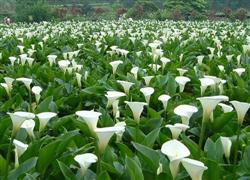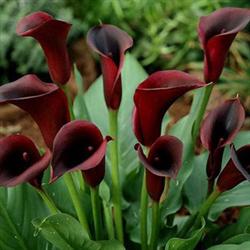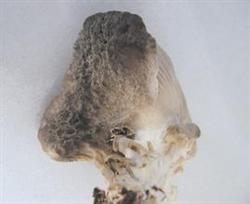Common diseases and insect pests of colored calla lotus

The common diseases of colored calla lilies are mainly bacterial diseases, fungal diseases and insect pests, which are introduced below. Bacterial disease: Euclid disease, also known as soft rot, is caused by a variety of carrot caused by carrot soft rot. The infected leaves and stems turn dark green, with necrotic and rotten spots, secrete mucus, and eventually the plant falls out. The tubers also began to rot and stink. When the plant does not grow well, it can cause infection through some small wounds. These bacteria can also secrete enzymes to dissolve the cell wall and penetrate the plant. If the plant is dry, the infected plant and the soil on which it grows should be carefully removed. Attention should be paid to picking out those infected tubers as early as possible before planting and carrying out disinfection prevention. The sensitivity to Euclid infection varies with different varieties. Generally speaking, yellow and orange varieties are more susceptible to infection than white and cream varieties. The best control method is to provide the plant with the best growth environment from beginning to end during cultivation, so that it can develop without interference. The growing environment of colored calla lilies should meet the following requirements:? provide sufficient moisture (do not plant too shallow; water again when the soil dries); the drainage performance of the soil should be good to prevent the occurrence of over-wetting; avoid excessive temperature in the greenhouse, especially when the relative humidity is high. Prevent damage to plants and tubers (prevent wind damage to plants, be careful not to let herbicides affect plant growth, and be careful when harvesting and handling); prevent damage caused by other fungal diseases and pests. (for example, damage caused by Pythium or Rhizoctonia may provide a port for the invasion of Orbsiella); do not use too much nitrogen fertilizer, as more than 150 kg of nitrogen fertilizer per hectare can easily cause infection. Tubers should be dried as soon as possible after harvest: if there is a delay in the first week after harvest, it will cause a lot of loss in the future. Fungal disease rot mold: this fungus can cause root rot, limiting the absorption of water by the plant. Crop rotation and precise irrigation (and drainage) are important factors in preventing infection. Steam disinfect the soil and treat it with fungicides before planting. Rhizoctonia: this fungus damages the buds of plants near the ground. Methyl parathion and fluoramide can be used to treat soil to control the bacteria. Penicillium: this fungus can cause infection during storage and damage to tubers during and after storage, especially when tubers are mechanically damaged, the relative humidity in the storeroom is too high or the air flow in the microenvironment is insufficient. Provide adequate air flow to prevent the occurrence of the bacteria. Fungicides can also be used to disinfect tubers, such as carbendan. Botrytis cinerea: can occur on flowers and leaves. It is necessary to prevent the combination of fungicides and pesticides every 10 days when cultivated in the open air. The infection of Botrytis cinerea almost showed the formation of small spots on the leaves. Only one call at the end of August or early September is enough for prevention. Pest thrips and aphids can cause damage throughout the growth of the plant. Parathion is sprayed twice before flower picking, and acephate or deltamethrin can be used for prevention every 10 days during cultivation.
- Prev

Common diseases and insect pests of colored calla lotus
The common diseases of colored calla lilies are mainly bacterial diseases, fungal diseases and insect pests, which are introduced below. Bacterial disease: Eucella disease, also known as soft rot, is caused by a variety of carrot soft rot caused by carrot soft rot. The infected leaves and stems turn dark green with necrotic and rotten spots.
- Next

How to prevent deformed Pleurotus ostreatus in winter
It is a good season to cultivate Pleurotus ostreatus because of the low temperature in winter and less miscellaneous bacteria in the air. However, the following kinds of deformed mushrooms are easy to appear in mushroom culture: after the occurrence of Pleurotus ostreatus primordium, the speed of cap differentiation and development is abnormal, which is characterized by small cap, long stalk, thick and hard stalk and low commercial value. The main reason for this is the adoption of.
Related
- Fuxing push coffee new agricultural production and marketing class: lack of small-scale processing plants
- Jujube rice field leisure farm deep ploughing Yilan for five years to create a space for organic food and play
- Nongyu Farm-A trial of organic papaya for brave women with advanced technology
- Four points for attention in the prevention and control of diseases and insect pests of edible fungi
- How to add nutrient solution to Edible Fungi
- Is there any good way to control edible fungus mites?
- Open Inoculation Technology of Edible Fungi
- Is there any clever way to use fertilizer for edible fungus in winter?
- What agents are used to kill the pathogens of edible fungi in the mushroom shed?
- Rapid drying of Edible Fungi

